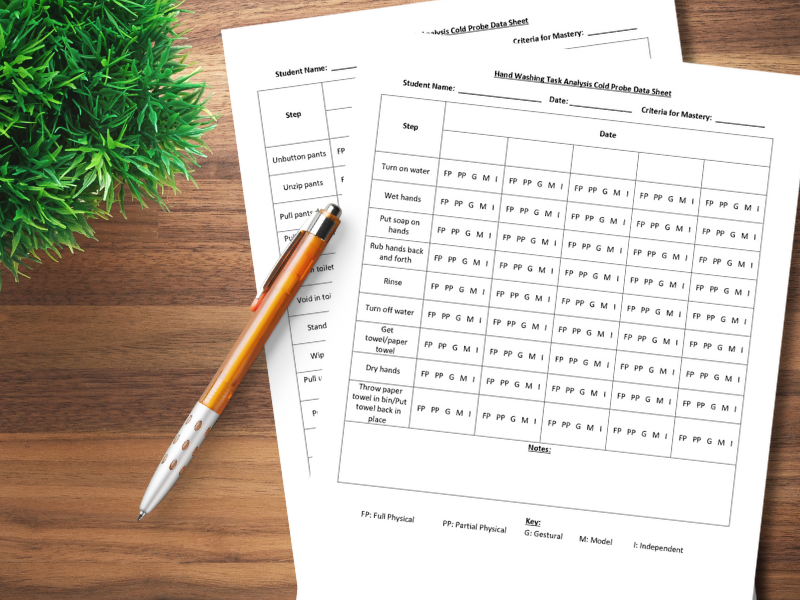BLOG POST
Using Task Analysis in ABA Therapy
Published on 22nd December 2023 by ABA Simplified
Estimated Reading Time: 7 minutes


We’ve been Exploring Effective Interventions in ABA. This week, we’re looking at Task Analysis. Whether you’re a student pursuing ABA, a BCBA, RBT, special education teacher, or a paraprofessional, you’ve probably heard the term task analysis. It might sound very complicated but, it’s just a fancy way of saying we’re analyzing the steps in this task and teaching them one step at a time. They’re one of our most commonly used teaching strategies so we’re going to jump right into why they’re so important and how we can effectively use them in our sessions.
What is a Task Analysis?
As I mentioned earlier, task analysis is simply the process of breaking down complex skills or behaviors into smaller, more manageable steps. This method allows us to teach our learners these complex skills in a way that is easier for them to learn since we’d be focusing on teaching one step at a time. We can use task analysis to teach pretty much anything and everything, ranging from basic daily living activities to more advanced academic or social skills (think ordering a Subway sandwich, or scheduling a doctor’s appointment).
What Are the Benefits of a Task Analysis?
- Consistency: Task Analysis promotes consistency in teaching methods. Think of the number of ways there are to do any single task. Let’s take washing our face as an example. Some people may want to pump soap on their hands first, some may want to wet their hands first. Some turn off the tap while washing their face, other keep the tap running. So when we have parents, grandparents, therapists, special educators etc working with our learners, imagine the confusion when our learners have to follow a different method with every person! A task analysis helps minimize confusion by providing a single method that everyone can follow, allowing for cohesive and uniform instruction.
- Individualized Learning: Task analysis facilitates individualized learning by allowing educators and behavior analysts to tailor the steps based on the learner’s unique abilities and needs. It also allows us to add in any accommodations that might be needed (think supports for motor deficits e.g. using a special tool to open a jar). It also helps us identify specific steps that our learners might be struggling with allowing for more targeted instruction for those steps.
- Promotes Acquisition of Complex Behaviors: Task analysis simplifies the learning process by breaking down complex behaviors or skills into smaller, more manageable steps. This systematic approach enables the learner to focus on mastering one step at a time, gradually building toward the complete skill. Whether it’s learning social interactions, academic tasks, or daily living activities, task analysis provides a structured approach for teaching these skills and behaviors.
Teaching Complex Behaviors Using Chaining
- Forward Chaining: In this approach, the steps of a task are taught in chronological order using prompting and prompt fading. The learner is taught to complete the first step in the chain until they achieve mastery of that step. While the first step is being taught, they are prompted through the other steps in the chain. Once the learner consistently completes the first step, they are then taught to complete steps 1 and 2 independently, while being prompted through the rest of the steps. This process continues until the learner can independently complete all the steps in the chain.
- Backward Chaining: This method is very similar to forward chaining; except we start with the last step first. Learners are prompted through the entire chain with the exception of the last step in which prompts are faded, allowing them to independently complete the step. Once they consistently complete the step on their own, they are taught to complete the last two steps and so on until they can independently complete all steps in the chain. The benefit of this method is that they are able to immediately experience natural reinforcement via completion of the chain rather than having to be prompted through the remainder of the steps to receive that reinforcement.
- Total Task Presentation: With this method, learners are simultaneously taught all steps at the same time, using prompting and prompt fading. Let’s say that our learner is learning to wash their hands. Instead of prompt fading only the first or last step as with forward or backward chaining, we would prompt and prompt fade with every step. Once our learners have mastered a particular step at a specific prompt level (example: partial physical prompt), we’d move to the next least intrusive prompt in the hierarchy (example: gestural).


Using Task Analysis in Skill-Acquisition Programs
The National Professional Development Center (NPDC) has outlined the following steps to successfully implement a task analysis –
- Identify The Target Skill: The target skill should consist of a series of steps that can be chained. A single discrete skill is not appropriate, neither is a task that can have many variables or outcomes. Think about the skill of making a sandwich. Simply getting bread out of the bag is a single, discrete skill, and making a sandwich can be too complex and have several variable outcomes – is the learner making a PB&J, or BLT, or other another sandwich with different toppings? Outlining the specific ingredients and steps to make a specific sandwich would be perfect here.
- Identify Any Pre-Requisite Skills: Identify any pre-requisite skills the learner will need as part of the task analysis. This will help you know how detailed the task analysis needs to be. Consider showering – does your learner know which body parts need soap or do we need to specifically outline all the body parts that must be soaped?
- Breaking the Skill into Components: Break the skill down into its component steps so that it is easier to understand and teach your learner. If your learner consistently has trouble with a specific step, then you’ll know you need to dive a bit deeper to find any missing pre-requisities or figure out if accommodations will be needed. For example, if your learner has difficulty brushing their teeth because of challenges discriminating between the front and back of their teeth, can we use a 3-sided toothbrush instead? Once you’ve broken the skill down into its individual steps, make sure to re-check your task analysis by observing a competent individual performing the sequence of behaviors, consulting with an expert or person highly skilled in the particular tasks to be taught or performing the entire sequence yourself.
- Confirming that the Task is Completely Analyzed: The best way to make sure that each step is properly accounted for, have someone else (a different learner, your colleague, spouse or anyone else) follow the steps exactly as written. Here’s a hilarious example I love using in my training sessions!
- Determining How the Skill Will be Taught: Now that you have all your steps written out, you’ll need to figure out the best way to teach your learner. You’ll want to consider if this task analysis has been taught before, and why it failed – did the learner have challenges mastering the steps and why? Did the skill fail to maintain and why? Does the learner learn better DTT style or by embedding the skill into naturally occurring routines? Also, consider how the task analysis will be presented to your learner. Will you use pictures with text or without text? Will you skip pictures and just give them a list of steps if they can read? Do they need a video model instead? I used to default to using images with text with all my learners until one day I just couldn’t teach one of my kiddos how to wash their hands! I decided to give video modeling a shot and within a few sessions, the skill had been mastered so if you’re struggling with a specific skill, try changing up your teaching method!
- Monitor Progress: As always, make sure you take data, monitor progress, and make changes as needed!
Overall, the systematic approach to task analysis not only simplifies the teaching process, but also promotes consistency in teaching methods, a crucial aspect when multiple people are involved in the therapy process.
If you need data sheets for your task analyses, check out the Task Analysis Data Sheets Bundle that covers a range of daily living skills such as toileting, handwashing, showering, bathing, washing face, making the bed, doing laundry, washing dishes, and more. You’ll also get a printable and digital template that you can use with your own task analyses! This is a growing bundle which means that the price you pay at the time of purchase will give you access to all future data sheets at no extra cost! Click the image below to check it out!


Sign Up For Blog Updates!
Subscribe to stay in the loop with my latest blogs!
Thank you!
You have successfully joined our subscriber list.


